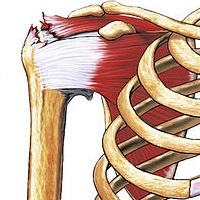
Photo from wikipedia
Background Calcific tendinitis of the rotator cuff is one of the most common causes of shoulder pain. Ultrasound guided percutaneous lavage of calcific tendinopathy (UGPL) is indicated when conservative treatments… Click to show full abstract
Background Calcific tendinitis of the rotator cuff is one of the most common causes of shoulder pain. Ultrasound guided percutaneous lavage of calcific tendinopathy (UGPL) is indicated when conservative treatments have failed. It has been shown that dense calcifications are associated with a higher risk of treatment failure. Sodium thiosulfate (STS) has recently been used with success in the treatment of tumoral calcinosis. We hypothesised that STS lavage could be of interest in the treatment of dense calcification of the rotator cuff. Objectives To evaluate the tolerance and efficacy of sodium thiosulfate lavage in the treatment of calcific tendinitis Methods This was a prospective phase II open label study. We included only patients with a type A calcification according to the Molé classification. Patients were treated with a US-guided single needle technic. When backflow of calcific material could be identified in the syringe, lavage of the deposit was performed using STS 25% until the backflow becomes clear followed by the injection of 1 mL (250 mg) of STS inside the calcific deposit. Finally, 1.5 mL of cortivazol was injected in the subacromial bursa. All patients had follow-up visits at 1 week, 1 month and 3 months after intervention. At each time point, VAS pain at rest and during activities was recorded and US and X-ray were performed. Our primary outcome was the percentage of patients with more than 50% of decrease of the calcification size at 1 month. Based on our experience and on the literature, we expected than more than 60% of the patients should have more than 50% of decrease in their calcification for the results to be significant. Results A total of 17 patients were included. Mean age was 50±11 years. There were 9 female (52.9%). Baseline VAS at rest and during daily activities was a mean 40.2±25.9 and 65.5±21.6 (27–91) respectively. Calcification involved the supraspinatus in 12 cases (70.6%) and the infraspinatus in 5 cases (29.4%). Mean surface on radiography was 80.7 mm2 ±52.4 and the calcification longest size was 18.8±7.1 mm. All patients underwent the entire procedure with no adverse event apart of a mild and transient vasovagal reaction. Calcium backflow could be obtained in 15 patients (88.2%) with a small amount of calcium in 8 cases (53.3%) and a large quantity in 7 cases (46.7%). We found that 5 patients (30%) had more than 50% decrease of their calcific deposit at 1 month and 8 (47%) patients at 3 months. VAS pain during activities and at rest decreased significantly from 65±22 and 40.2±26 at baseline to 37.8±31 and 24.1±24 at 3 month respectively (p=0.0004; p=0.001) Conclusions Overall, our study is the first to evaluate the tolerance and efficacy of sodium thiosulfate for the treatment of the calcifications of the rotator cuff. We could not demonstrate a significant effect of one STS lavage and injection in patients with dense calcification. This treatment was well tolerated with no side effect occurring during the procedure and the follow-up. New studies using larger volume and repeated injections of STS will be needed to definitely conclude on the interest of this molecule in the treatment of calcific tendinopathies. Disclosure of Interest None declared
Journal Title: Annals of the Rheumatic Diseases
Year Published: 2018
Link to full text (if available)
Share on Social Media: Sign Up to like & get
recommendations!